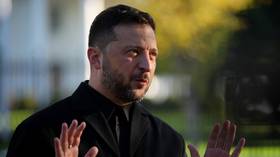Penny Lane: CIA secret camp for turning Gitmo prisoners into double agents

In the early stages of the ‘War on Terror,’ CIA agents at the Guantanamo Bay detention facility turned detainees into double agents, helping the US to track and kill terrorists, according to US officials.
For some Gitmo detainees, held prisoner on a US military base in
the middle of shark-infested waters, the promise of freedom in
return for helping the CIA root out terrorists back home may have
proven too much of a temptation.
In addition to winning their freedom, co-conspirators were
granted safety guarantees for their families, and millions of
dollars from the agency's secret war chest, sources told AP.
The arrangement did not come without some inherent risks,
however, since – as the war in Afghanistan has proven on various
occasions - it is not uncommon for US troops to suddenly become
the target of ‘friendly foreign fire.’
In January 2002, 632 detainees arrived at Gitmo, followed by 117
the next year. Suddenly, the risk of building a strategic
partnership with the enemy seemed worth taking. The CIA,
recognizing an opportunity for breaching the mountain hideouts of
elusive terrorist targets, seemed prepared to release some
prisoners from the harsh conditions of their indefinite
detention.
'Behind the shelter…'
A few hundred yards behind the Gitmo detention facility,
concealed behind vegetation and rock formations, sits eight
unassuming barracks, known to those in the know as ‘Penny Lane’.
Given the relative comfort of the compound’s units, which were
said to have had “private kitchens, showers and…real bed with
a mattress,” CIA personnel jokingly referred to the complex
as ‘the Marriott’.
The intelligence agency was then tasked to recruit potential
candidates into the program. Of the ‘dozens of prisoners’
evaluated for the special program, only a handful signed
agreements to work for American intelligence.
"Of course that would be an objective," Emile Nakhleh, a
former top CIA analyst who spent time in 2002 assessing detainees
but who did not discuss Penny Lane, revealed. "It's the job of
intelligence to recruit sources."
To qualify for the program, recruits needed good connections with
terrorist organizations, notably Al-Qaeda.

Once accepted into the secret program, candidates were instructed
by the US intelligence agency to spy on behalf of the CIA in its
effort to capture or kill Al-Qaeda operatives, current and
retired US officials told the Associated Press.
The sources spoke on condition of anonymity because they were not
authorized to discuss the program, which ended in about 2006.
CIA spokesman Dean Boyd declined to comment.
"I do see the irony on the surface of letting some really very
bad guys go," David Remes, an American lawyer who has
represented about a dozen Yemeni detainees at Guantanamo, told
AP.
"The men we were sending back as agents were thought to be
able to provide value to us," he added.
Penny Lane continues the US military’s trend of borrowing famous Beatles’ songs to name their facilities. In 2010, The New York Times broke the story on a clandestine facility disturbingly dubbed ‘Strawberry Fields’, since it was believed that the ‘high value’ inmates detained would be there, as the well-known lyrics say, ‘forever’. These individuals were referred to as ghost detainees, and were held for years by the CIA in secret ‘black site’ prisons across Europe, as well as in the Middle East and Asia.
AP sources confirmed that some of the double agents did help
track down and kill terrorists, while other operatives ceased
cooperation and the CIA lost contact with them.
The biggest fear, former officials involved with the program
recalled, was that a former detainee would attack Americans then
publicly announce that he had been on the CIA payroll.
The US government had such high hopes for Penny Lane that one
former intelligence official recalled discussions about whether
to secretly release a pair of Pakistani men into the United
States on student or business visas. The hope was that they would
connect with Al-Qaeda and lead authorities to members of a US
cell.
Another former senior intelligence official said that never
happened.
Meanwhile, efforts to shut down Gitmo, which has been labeled the
‘Gulag of our times’, by Amnesty International, remains an
unfulfilled promise by the Obama administration, which has met
fierce resistance to the idea by members of the Republican Party,
most notably former Vice-President Dick Cheney.
“I can tell you that the administration remains committed to
closing the detention facility at Guantanamo Bay,” deputy
White House press secretary Josh Earnest announced in March.
Of the 779 people initially detained at Guantanamo Bay, more than
three-quarters have been released, while others who have been
cleared for release continue to remain at the facility.














